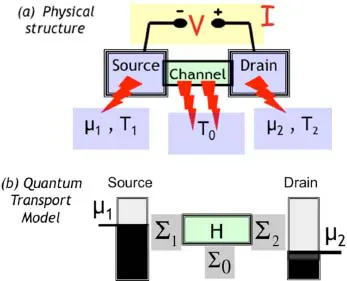
- 492 pages
- English
- ePUB (mobile friendly)
- Available on iOS & Android
About this book
Everyone is familiar with the amazing performance of a modern smartphone, powered by a billion-plus nanotransistors, each having an active region that is barely a few hundred atoms in length.
These lecture notes are about a less appreciated by-product of the microelectronics revolution, namely the deeper understanding of current flow, and device operation that it has enabled, which forms the basis for a new approach to transport problems.
The book assumes very little background beyond linear algebra and differential equations, and is intended to be accessible to anyone in any branch of science or engineering.
Readers are encouraged to visit the website http://nanohub.org/groups/lnebook to access revisions, corrections, video lectures, tutorials, quizzes and also to join a Q&A forum based on questions from readers.
Contents:
- The New Ohm's Law:
- The Bottom-Up Approach
- Why Electrons Flow
- The Elastic Resistor
- Ballistic and Diffusive Transport
- Conductivity
- Diffusion Equation for Ballistic Transport
- What about Drift?
- Electrostatics is Important
- Smart Contacts
- Old Topics in New Light:
- Thermoelectricity
- Phonon Transport
- Measuring Electrochemical Potentials
- Hall Effect
- Spin Valve
- Kubo Formula
- Second Law
- Fuel Value of Information
- Contact-ing Schrödinger:
- The Model
- Non-Equilibrium Green's Functions (NEGF)
- Can Two Offer Less Resistance than One?
- Quantum of Conductance
- Rotating an Electron
- Does NEGF Include “Everything”?
- The Quantum and the Classical
Readership: Students and professionals in any branch of science or engineering.
Frequently asked questions
- Essential is ideal for learners and professionals who enjoy exploring a wide range of subjects. Access the Essential Library with 800,000+ trusted titles and best-sellers across business, personal growth, and the humanities. Includes unlimited reading time and Standard Read Aloud voice.
- Complete: Perfect for advanced learners and researchers needing full, unrestricted access. Unlock 1.4M+ books across hundreds of subjects, including academic and specialized titles. The Complete Plan also includes advanced features like Premium Read Aloud and Research Assistant.
Please note we cannot support devices running on iOS 13 and Android 7 or earlier. Learn more about using the app.
Information




Table of contents
- Cover Page
- Book Title
- Prelims
- TitlePage
- Copyright
- Dedication
- Preface
- Acknowledgement
- Symbols
- Contents
- DetailedContents
- I. The New Ohm's Law
- II. Old Topics in New Light
- III. Contact-ing Schrdinger
- References
- Appendices